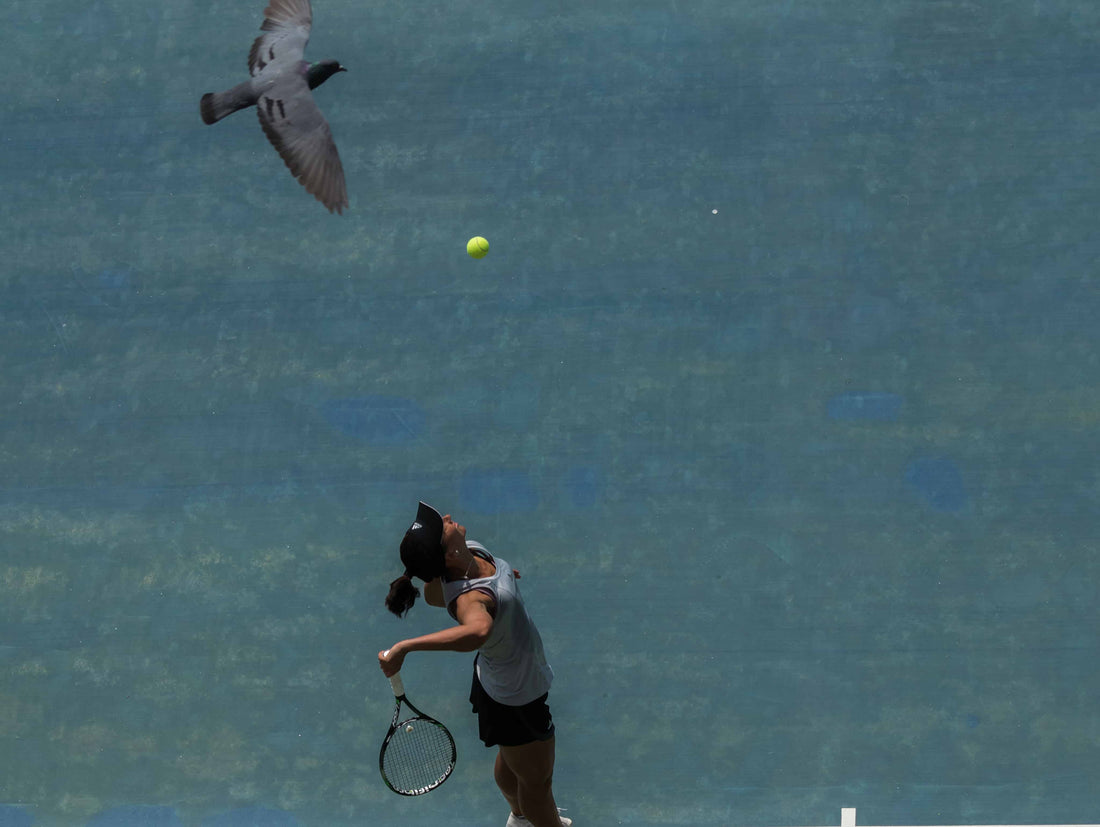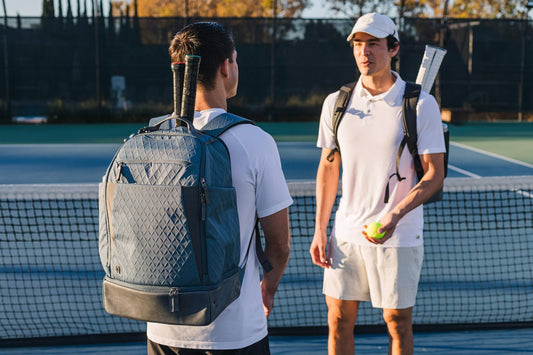Can we all agree that hindrances are a bother? But what exactly is a hindrance in tennis? According to the USTA, “A hindrance refers to a situation in which a player is hindered from making a shot by anything that is not within the player’s control other than a permanent fixture or a spectator’s outcry.” This definition is a bit vague, so we’re going to break down what qualifies as a hindrance and what you should do if a hindrance occurs during play.
Download our Cheat Sheet
Permanent Fixtures
Permanent fixtures are NOT hindrances.
As mentioned in the definition of a hindrance, permanent fixtures on or around the court are not considered hindrances. These include: backstops and sidestops (i.e., walls or fences), scoring devices, officials’ chairs, spectators, stands and seats for spectators, and all other fixtures around and above the court. The category even includes players on adjacent courts, even though they move!
If the ball touches a permanent fixture after it lands in the correct court, the player who hit the ball wins the point. If the ball touches a permanent fixture before it hits the ground, the player who hit the ball loses the point. If a serve touches a permanent fixture before it lands in the service box, it’s a fault.
Now that we’ve covered permanent fixtures, we’re going to look at what does qualify as a hindrance.
Types of Hindrances
Talking
While most of us play tennis socially, we have to learn to save the chatting for between and after games and sets. In singles, players should not talk during points since there is no need for it, and talking would be considered a distraction. However, communication is key for a doubles team to succeed, so when is talking allowed and disallowed in doubles? If talking with your partner is more of a distraction for your opponents, then it’s not allowed. In other words, when the ball is moving toward your team, you can talk to your partner to strategize, but if your team has already hit the ball and it’s moving toward the opponent’s side of the court, then talking would be considered a hindrance. Furthermore, any talking that interferes with your opponent’s ability to play a ball is a hindrance.
For example, if you hit a shot out wide and as your opponent is getting ready to hit the ball back, you yell at your partner to cover her alley, the opponent could claim the point based on a deliberate hindrance. Hindrances need to be claimed immediately, so if the opponent attempts to return the shot and misses, she can’t claim the hindrance after the point is over.

If the “talking” takes the form of yelling as a result of an injury, an insect bite, etc., the hindrance would be considered unintentional, and the opponent could call a let but does not win the point outright.
Grunting
Does your club have its own version of Maria Sharapova or Serena? If so, you might be tempted to claim a hindrance when you hear her grunt, but according to The Code, although grunting and other loud noises are distracting, only officials may rule them as hindrances and call a let or award the point. If an official is involved, the grunter should receive a warning first. Presuming that most of you are playing unofficiated matches, if you are indeed playing a Monica Seles, maybe you can remind her that The Code suggests that players should avoid grunting and hope that she doesn’t get too angry with you.
Outside Noises
While you and your opponents can control the noises that you make on the court, you can’t control the noises that come from off the court. Unfortunately, if you get distracted by an out call or other noises from spectators, you can’t claim a hindrance, which means you can’t call a let or claim the point. On the other hand, if your opponent’s cell phone rings (vibrating doesn’t count) during a point, which is something she could have prevented, you may immediately stop and claim the point. Since that’s the case, the next time you’re down break point, have your friend who’s watching your match give your opponent a call and see if you can win a free point (just kidding, please don’t do that!).
Repeated Requests
Most hindrances are unintentional, but something that could qualify as a deliberate hindrance is when you make a repeated request of your opponent, but the opponent ignores the reasonable request. For example, if you ask the server several times to stop discarding the second ball after serving, and the server continues to discard the second ball, the action is considered an intentional hindrance, and you can stop play immediately and claim the point when it happens.
Body Movements
When it comes to body movements, the line is a little blurrier as to what is a hindrance and what isn’t. In general, movements that are naturally part of a player’s method of playing tennis are allowed, including moving around while the server is getting ready to serve. A player can even deceive her opponent with her movement to make her opponent think she’s going to hit the ball in the other direction. However, any movement that is made intentionally in order to distract the opponent, such as waving the arms or racquet or stomping feet can be claimed as a hindrance.
Loose Items
While it may not always be in a player’s control, The Code mentions that a racquet coming out of the hand or a shoe coming off is not the basis for either player claiming a let because those things should be within the player’s control. Likewise, a player tripping over her own hat or sunglasses is not the basis for a hindrance, but if a player’s hat or sunglasses fall off during a point, the opponent may call a let due to unintentional hindrance.
Injuries
Although we hate when anyone gets injured during a tennis match, injuries do occur. When a player accidentally injures her opponent, the injured player suffers the consequences and is forced to retire from the match if she cannot recover within the time limit allotted for medical attention. If the injury isn’t too serious, play should continue, and the point during which the injury occurred goes to whoever won the point.
If, on the other hand, the player intentionally does something that results in her opponent getting injured, such as by throwing a racquet in anger, then the opponent wins the match by default if it’s a game-ending injury, or she wins the point if she can continue playing.
When something outside of either player’s control causes an injury, such as a bee sting, a hindrance can be called if it can be proved, and the point should be replayed.
What Should Happen When a Hindrance Occurs?
If your opponents talk when they shouldn’t, a cell phone goes off during a point, or you encounter some other form of a hindrance, you must stop play as soon as possible to claim the hindrance and either play a let or win the point depending on the situation. Since timing is key, you should make sure you know what qualifies as a hindrance and what doesn’t so if one occurs, you can stop play immediately.
 In simple terms, if the hindrance was deliberate or on purpose, you win the point automatically. If the hindrance was unintentional or accidental, or it was something outside of the opponent’s control (but not involving a permanent fixture), you should call a let and replay the point.
In simple terms, if the hindrance was deliberate or on purpose, you win the point automatically. If the hindrance was unintentional or accidental, or it was something outside of the opponent’s control (but not involving a permanent fixture), you should call a let and replay the point.
Keep in mind, however, that The Code gives a further qualification: the hindered player is only entitled to a let if you could have made the shot had you not been hindered. So if a ball comes rolling onto your court during a point as your opponent hit a powerful overhead smash that bounces well above your head and into the fence, you aren’t allowed to call a let since even if the stray ball had never rolled into your court, you never had a chance of returning that smash successfully.
The ITF Rules give a few cases to help clarify some confusing scenarios. For example, they remind us that only the player who is being hindered can stop a point and claim a hindrance. If you think your opponent is being hindered and you stop the point, you will lose that point. Regarding permanent fixtures, if something that is on the court gets in the way, but it could have been moved before the start of the point, such as a spare ball, it does not count as a hindrance because it has become a permanent fixture on the court. The same is true of a shirt draped over the net or a water bottle placed on the net post. If a ball hits something that is flying over the court, such as a bird, that’s not a permanent fixture, and it qualifies as a hindrance.
Conclusion
Undoubtedly, there will be instances that you encounter on the court that may cause confusion as to whether or not a hindrance occurred, but hopefully you now have a better idea of what qualifies as a hindrance and whether you can claim the point or play a let if one does happen. All in all, don’t let hindrances become too much of a bother, and don’t forget to put your cell phone on silent before your next match!
Download our Cheat Sheet
Adapted from ITF Rules of Tennis and The Code: The Players’ Guide to Fair Play and the Unwritten Rules of Tennis





